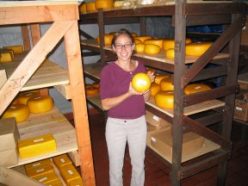News Detective: Emily Visits a Cheese Lab
An hour before I visited the cheese lab at the University of Minnesota in St. Paul, the milk truck broke down. It was supposed to deliver 3,000 pounds of fresh milk. Without it, Lloyd Metzger and his colleagues had to scrap their plans to make havarti and dill havarti cheese that day.
 |
| Emily picks a cheese. |
I wasn’t completely out of luck, though. Cheese-maker Jodi Ohlsen Read had leased space in the lab to work on her recipe for a cheese called Sheep’s Milk Bleu. Read owns a farm called Shepherd’s Way, near Northfield, Minn., about an hour south of St. Paul. She makes most of her cheese on the farm, but when she needs to work out some kinks in a new recipe, she likes to use research equipment at the university.
When I arrived at the lab, Read and her assistant, Josh Dix, were tending to a huge vat full of a thick, yogurt-like substance. The milk had already been heated, pasteurized, and mixed with salts, enzymes, and molds. Now they were cutting it by hand into mini-marshmallow-sized chunks. As they sliced with a large metal knife, the curds solidified, releasing lots of watery whey.
At one point, Read handed her cutting tool to Ray Miller, coordinator of the university’s cheese plant. She calls him a “cheese guru” because he has lots of experience. And he can rattle off cheese statistics with impressive speed and accuracy. Miller also happens to be very tall.
“He makes it look effortless,” Read said, as she watched Miller slice through the cheese like butter. “That’s not the case.”
Making cheese is hard work. I worked up a sweat just watching the process.
Nevertheless, cheese scientists are a dedicated bunch. After 12 years as a writer, Read switched to making cheese, and she has never looked back.
“The best part is the magic of it,” Read said. “You start with milk at the beginning of the day, and you end up with all of these little cheeses. You are creating something.”
Miller the guru, whose father was in the cheese business for more than 40 years, has been eating and working with cheese for most of his life. His favorite part about making cheese is the scientific aspect.
“It’s a fascinating science,” he says. “Cheese is a living system. Even when it’s in the cooler ripening, chemical reactions are taking place. Enzymes are breaking things down, increasing flavor compounds. It’s always changing. No two lots of milk are identical. It’s a variable system, but you know you have to create consistency.”
Science aside, there’s also a much simpler pleasure in being a cheese scientist, Metzger says. “It’s nice,” he says, “to be able to eat your work.”—E. Sohn